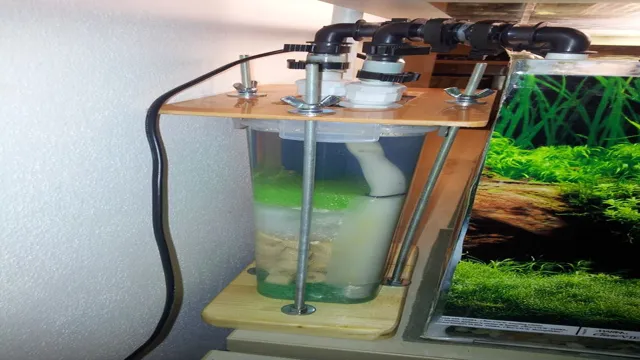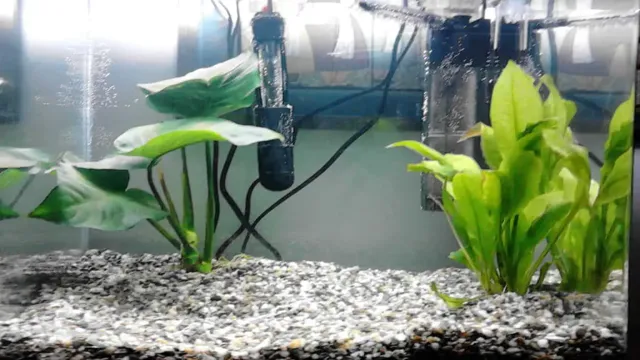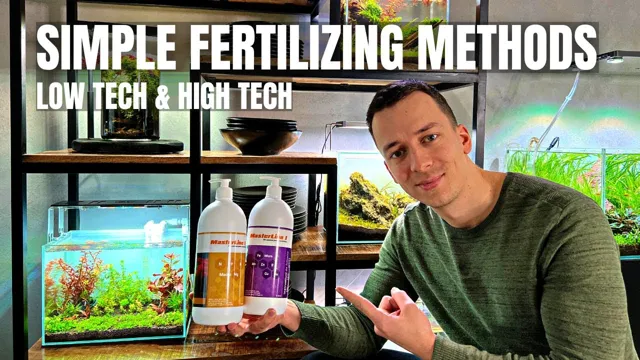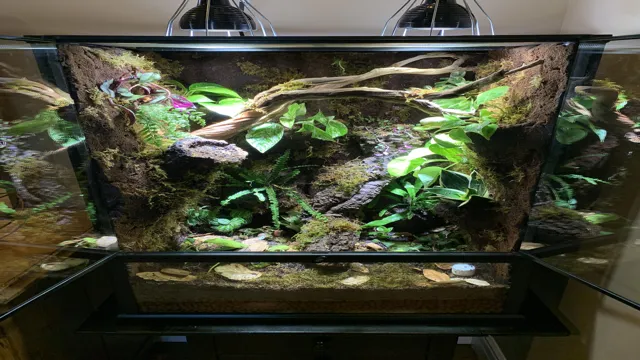As an aquarium owner, the quality of water is crucial to the health and wellness of your aquatic inhabitants. Filtering water in your aquarium is essential to remove harmful toxins, chemicals, and waste products that can lead to fish illness or even death. Luckily, there are many filtration options available, from simple options to more advanced setups designed for larger tanks.
But where do you begin? How do you know which filter is right for your aquarium? Let’s dive in and explore the world of filtering water in your aquarium, so you can ensure your underwater pets are living in a safe and clean environment.
Why You Need to Filter Your Aquarium Water
If you’re a fish-keeping enthusiast, you need to have a filtration system in place to help maintain a healthy environment for your aquatic pets. A proper filtration system is essential to filter out debris, toxins, and other harmful substances that can contaminate the water. It’s vital to know how to filter water in your aquarium to ensure your fish live in a clean and healthy environment.
Without proper filtration, the water quality can deteriorate very quickly, and your fish can suffer. A high-quality filter goes a long way in ensuring that the water in your aquarium stays healthy, clear, and free from harmful toxins. By choosing the right filter, you can keep your fish happy and healthy for years to come.
Maintain Clean and Clear Water
Maintaining clean and clear water in your aquarium is crucial for the health and well-being of your aquatic friends. One of the best ways to achieve this is by using a filter. But why exactly do you need to filter your aquarium water? Well, aquariums can quickly become a breeding ground for harmful bacteria, excess waste, and toxins, especially if they are overstocked or not properly maintained.
A water filter is designed to remove these impurities and ensure your fish have a safe and healthy environment to live in. Filters work by circulating and oxygenating the water, which helps to break down waste and debris, making it easier for the filter to trap them. Once these impurities are removed, your aquarium water will be cleaner, clearer, and less likely to harm your fish.
In addition to promoting the health of your fish, filtering your aquarium water also helps to maintain the overall aesthetic of your tank. Clear, clean water showcases your fish and their habitat, making for a more enjoyable viewing experience. So if you’re wondering whether or not you should invest in a filter for your aquarium, the answer is a resounding yes! With regular filter maintenance and water changes, your fish will thrive in a clean and healthy environment, and you’ll enjoy a beautiful and captivating display to show off to your guests.

Improve Water Quality and Fish Health
If you have an aquarium, one of the most important things you can do to ensure the health and well-being of your fish is to filter the water. Aquarium filters help to remove waste, debris, and harmful chemicals from the water, improving water quality and promoting healthy fish. In an enclosed environment like an aquarium, waste and uneaten food can build up quickly, leading to high ammonia and nitrite levels that are toxic to fish.
A good filtration system can prevent these issues and create a healthy environment for your aquatic pets to thrive. Keep in mind that not all filters are created equal, so be sure to choose one that is appropriate for the size and type of aquarium you have. With proper filtration, you can enjoy a beautiful and thriving aquarium while also ensuring the health and well-being of your fish.
Types of Aquarium Filters
If you’re wondering how to filter water in your aquarium, there are a few different types of aquarium filters to consider. One option is a hang-on-back filter, which is easy to install and hangs on the side of the tank. Another option is a canister filter, which sits outside of the tank and uses hoses to pump water through the filter media.
Power filters are another choice, which provide good mechanical and biological filtration. Sponge filters are another option, which use sponge material to trap debris and provide biological filtration. It’s important to choose a filter that’s appropriate for your tank size and the number of fish you have, as well as one that can handle the bioload of your aquatic pets.
Regular maintenance, such as cleaning filter media and changing filter cartridges, is also crucial for maintaining good water quality in your aquarium.
Mechanical Filters
Mechanical filters are an important type of filter used in aquariums to remove large debris and particles from the water. These filters work by trapping debris in a media, such as foam or fiber, which then allows the clean water to pass through. Mechanical filters come in different shapes and sizes, including canister filters, power filters, and internal filters.
Each of these filters operates differently, with some using media pads that require frequent cleaning and others utilizing rotating or vibrating pads that can be easily removed and cleaned. Mechanical filters play a critical role in keeping aquarium water clean and healthy for fish and other aquatic life. Without them, debris and pollutants can accumulate, leading to poor water quality and potential harm to the inhabitants of the aquarium. (See Also: How to Make an Aquarium Sump Pump: A Step-by-Step Guide)
Biological Filters
Aquarium Filters One of the essential tools for maintaining a healthy and balanced aquarium is a filter. Filters come in various types, each with its unique functions and advantages. One popular type is a biological filter, which is responsible for breaking down organic waste in the tank.
This filter contains beneficial bacteria that convert toxic elements like ammonia and nitrite into less harmful substances. The bacteria thrive on surfaces like sponge, gravel, or bio-balls, which provide a vast surface area for them to grow and work effectively. A biological filter is particularly useful in a tank with heavy fish loads.
This filter helps to reduce the need for frequent water changes and keeps the water crystal clear. It is important to note that while a biological filter can significantly improve water quality, it works best in conjunction with other types of filters like mechanical and chemical filters.
Chemical Filters
When it comes to keeping your aquarium clean and healthy, having the right type of filter is crucial. One popular type of filter used in fish tanks is the chemical filter. These filters work by chemically removing harmful substances from the water, such as ammonia and nitrate, which can build up over time and harm your fish.
Some common types of chemical filters include activated carbon, zeolite, and ion exchange resins. Activated carbon is a porous material that absorbs impurities in the water, like a sponge. Zeolite, on the other hand, works by trapping ammonia and other harmful compounds and exchanging them for harmless substances.
Ion exchange resins work similarly to zeolite but are more effective at removing heavy metals and other toxins. Whether you’re just starting out with your first aquarium or are a seasoned fish hobbyist, a chemical filter can be a valuable tool for maintaining a healthy aquatic environment.
Choosing the Right Filter for Your Aquarium
When it comes to maintaining a healthy and happy aquarium, choosing the right filter is crucial. There are many different types of filters available on the market, each with their own pros and cons. The most common types of filters include power filters, canister filters, and sponge filters.
Power filters are great for smaller tanks and are easy to install and maintain. Canister filters are ideal for larger tanks and can handle a higher volume of water, but can be more expensive and difficult to set up. Sponge filters are a popular choice for breeding tanks as they offer gentle filtration and provide a place for beneficial bacteria to grow.
Ultimately, the type of filter you choose will depend on the size and type of your aquarium, as well as your own personal preferences. But one thing is for sure, a good quality filter is absolutely essential for keeping your aquarium water clean and healthy for your aquatic pets. And by regularly cleaning and maintaining your filter, you can help ensure that your aquarium remains a beautiful and thriving ecosystem for years to come!
Consider Your Tank Size and Type of Fish
When it comes to choosing the right filter for your aquarium, it’s important to consider not only the size of your tank but also the type of fish you have. Different fish species have different needs, and some produce more waste than others, which can quickly lead to poor water quality if not properly filtered. For smaller tanks, a simple hang-on-back filter might do the trick, while larger tanks may require a canister filter or even a sump.
If you have delicate fish or species that require specific water conditions, be sure to choose a filter that can accommodate those needs. Additionally, opt for a filter that has a high turnover rate, meaning it processes a larger volume of water per hour, to ensure your aquarium stays clean and healthy. By taking the time to choose the right filter for your specific aquarium, you can help ensure your fish thrive in a healthy and beautiful environment.
Look for Filter Features that Meet Your Needs
When choosing the right filter for your aquarium, it’s important to look for filter features that meet your specific needs. One of the most important things to consider is the size of your aquarium. If you have a large aquarium, you’ll need a filter that can handle the water capacity with ease.
Another important factor to consider is the type of fish and plants in your aquarium. Different types of fish and plants have different waste production levels and require different types of filtration. Additionally, it’s essential to find a filter that fits your budget and maintenance schedule. (See Also: How Thick is a 55g Aquarium: A Comprehensive Guide to the Glass Thickness)
Some filters require more maintenance than others, so it’s important to consider whether you have the time and resources to properly care for your filter. By considering all of these factors, you’ll be able to choose a filter that meets all of your needs and keeps your aquarium clean and healthy.
Installation and Maintenance of Your Aquarium Filter
If you want to know how to filter water in your aquarium, the first step is to select the right type of filter for your tank. There are three main types of filters: mechanical, chemical, and biological. Mechanical filters remove large particles from the water such as fish waste, uneaten food, and debris.
Chemical filters remove impurities such as excess ammonia, nitrate, and other toxins using activated carbon. Biological filters rely on bacteria to break down organic waste in the water. Once you’ve chosen the filter that suits your needs, it’s important to properly install and maintain it.
Make sure to follow the manufacturer’s instructions carefully to avoid any damage to your filter or tank. Regular maintenance, such as cleaning and replacing filter media, is crucial to keep your aquarium water clean and healthy for your fish and aquatic plants. Remember to monitor the water parameters regularly and adjust the filter as needed.
With the right filter and proper maintenance, you’ll be able to enjoy a crystal-clear aquarium that showcases the beauty of your aquatic pets.
Follow Manufacturer’s Instructions for Setup
As a new aquarium owner, it’s essential to follow the manufacturer’s instructions when setting up your aquarium filter. The filter is a critical component that helps keep your aquatic life healthy and happy. During installation, it’s crucial to ensure that all parts are secure, and the filter is positioned correctly in the aquarium.
After installation, regular maintenance is necessary to ensure the filter is working correctly. This includes cleaning the filter media and checking for any wear and tear. Remember, the filter is responsible for removing waste and debris from the water, so it’s essential to conduct weekly checks to ensure it’s functioning correctly.
By following the manufacturer’s instructions and conducting regular maintenance, you’ll be able to provide a clean and healthy environment for your aquatic pets to thrive. With a little effort and care, you’ll soon be on your way to becoming a successful aquarium owner!
Regularly Clean and Replace Filter Media
Regular maintenance of your aquarium filter is key to ensuring the health and wellbeing of your aquatic pets. One important aspect of this is regularly cleaning and replacing the filter media in your aquarium filter. Filter media refers to the materials in your filter that help to remove harmful particles and chemicals from the water.
Over time, these materials can become clogged and lose their effectiveness, which can lead to poor water quality. To prevent this, it’s important to regularly clean and replace your filter media according to the manufacturer’s guidelines. Not only can this help keep your water clean and clear, but it can also prolong the life of your filter.
So don’t neglect this crucial aspect of aquarium maintenance – keep your filter in tip-top shape by regularly cleaning and replacing your filter media!
Monitor Water Parameters and Adjust Filter as Needed
One of the most crucial aspects of maintaining a healthy aquarium is regularly monitoring the water parameters and adjusting the filter accordingly. Proper installation and maintenance of your aquarium filter can make all the difference in the quality of your aquarium’s water. Keeping an eye on the levels of ammonia, nitrite, and nitrate, as well as the pH level, will help you identify whether your filter is effectively removing waste and maintaining a healthy environment for your fish and plants. (See Also: How to Dissolve Hard Water Buildup from Aquarium: A Beginner’s Guide)
Adjusting the filter’s flow rate, adding or replacing filter media, and cleaning the filter on a regular basis will ensure that your system is working optimally. With these simple steps, you can enjoy a beautiful, thriving aquarium for years to come!
Conclusion
In the immortal words of the great Bob Marley, ‘You can’t control the waves, but you can learn to surf.’ In other words, while we can’t necessarily control the quality of the water in our aquariums, we can certainly learn to filter it properly. By investing in the right filtration system, regularly cleaning and maintaining your tank, and taking steps to minimize the amount of waste and debris that enters into your aquatic environment, you can create a healthy and vibrant underwater world for your beloved fishy friends.
So let’s get filtering and keep those waves of murky water at bay!”
FAQs
What are the benefits of filtering water in my aquarium?
Filtering water in your aquarium helps to remove harmful toxins and debris, providing a healthier environment for your fish and plants to thrive in.
What types of filters can I use to clean my aquarium water?
There are several different types of filters available for aquariums, including power filters, canister filters, sponge filters, and more.
How often should I clean my aquarium filter?
It’s recommended to clean your aquarium filter every 2-4 weeks, depending on the size of your tank and the type of filter you use.
What materials should I use to filter my aquarium water?
There are a variety of filtration media available for aquariums, including activated carbon, foam pads, bio-balls, and ceramic rings.
Can I use tap water in my aquarium, or do I need to filter it first?
Tap water can contain harmful chlorine and other chemicals that can be harmful to fish and plants. It’s recommended to filter tap water before adding it to your aquarium.
Do I need to use a UV sterilizer to filter my aquarium water?
While a UV sterilizer can be helpful in controlling algae and harmful bacteria, it’s not necessary for all aquarium setups.
How can I tell if my aquarium water is clean and healthy?
Testing your aquarium water regularly using a water testing kit can help you monitor the health and cleanliness of your aquarium water.







